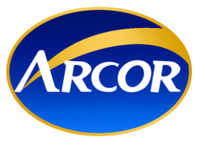Grupo Arcor
 Grupo Arcor
Grupo ArcorGrupo Arcor (name formed taking the first letters of the words "Arroyito" and "Córdoba": "AR-COR") is an Argentine food company specialized in confectionery. The firm was founded on July 5, 1951 in the city of Arroyito, Córdoba.
Arcor is an Argentine group that specializes in the production of foodstuff, sugar and chocolate confectionery, cookies and ice cream. It develops leading brands in its 39 industrial plants throughout Latin America. Currently, Arcor is the main foodstuff company in Argentina.
Arcor manages its business in a sustainable way with commercial offices in America, Europe, Asia and Africa. The company is the Argentine group with the greatest amount of open markets in the world, exporting its products to more than 120 countries in the 5 continents.
In 2012 Arcor ranked 1st. amongst the 100 most valuable companies of Argentina, according to the opinion of CEOs, financial analysts and journalists specialised in economics.
Arcor was born on 5 July 1951 when a group of entrepreneurs, sons of Italian immigrants, opened the first candy factory in Arroyito, Córdoba Province. They decided to call it "ARCOR", a name made from the combination of the first two letters of the word "Arroyito" and the first three of "Córdoba".
In 1958, Arcor reached 60,000Â kg of daily confectionery production and stopped being just a candy factory to start producing different product lines with the objective of providing itself with its strategic supplies. This allowed Arcor Group to offer the best quality at the fairest price.
In 1967, Arcor established its Official Distributors System. During all these years, the Company's production was intended for the domestic market, mainly the provinces. Its significant expansion towards Buenos Aires started in the early 70's.
In this same decade, Arcor consolidated its vertical integration through the construction of industrial plants in order to meet the different needs of the company –from raw materials to packaging, including even energy.
Meanwhile, the company kept on growing both in Argentina and in the different countries of the region: in 1976 it settled in Paraguay, in 1979 in Uruguay, in 1981 in Brazil and in 1989 in Chile.
The Group acquired Ãguila Saint (1993), one of the Argentine main chocolate companies. One year later, Arcor opened in Colonia Caroya the then largest and most modern model plant in Latin America for the manufacturing of chocolate.
In 1993, 35 years’ old accountant Luis Alejandro Pagani took on the presidency of Arcor Group. During his term in office, the group acquired Noel, a brand of foodstuff and sugar confectionery.
...
Wikipedia